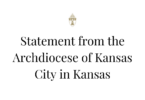by Sara Stacey
ATCHISON — “To experience India is in some ways to experience the history of humanity itself,” said Dr. Matthew Ramage. “It is one of, if not the, oldest civilizations on our planet.”
Ramage is a professor of theology at Benedictine College in Atchison, and he led a pilgrimage to India from May 18 to June 14.
“India exemplifies in a way like no other place the incredibly rich heritage of the world’s religions, and, in particular, the heritage of Catholicism,” said Ramage. The Indian subcontinent is home to three major Catholic rites, or traditions: Roman Catholicism, Syro-Malabar Catholicism, and Syro- Malankara Catholicism.
The vast majority of American Catholics are Roman, or Latin, rite, but the Catholic Church is actually comprised of six rites: Latin, Byzantine, Alexandrian (also called Coptic), Armenian, Antiochene and Chaldean. That means that Catholics practicing any of these rites are fully equal in dignity.
The “Syro” part of Syro-Malabar and Syro-Malankara is a reference to the traditions passed down from the church founded in Syria, Ramage said.
Because Christ didn’t leave a field manual on how to celebrate the sacraments, the apostles adapted and drew from the local cultures in order to evangelize, said Ramage.
For instance, in India, the cross looks like the ones hanging in American churches except for one thing — it is planted atop a lotus flower. The lotus flower, the national flower of India, appears frequently in Hindu creation myths, said Ramage.
This doesn’t mean that the Indian Catholics endorse Hinduism — rather, they see the cross of Christ embracing all of creation.
Anne Faucett, director of international admissions and retention for Benedictine College, is a Midwestern Roman Catholic who had never experienced another rite before.
“It was different,” she admitted.
For example, “everything was sung,” said Faucett. And Ramage described the chanting as “beautiful,” “otherworldly,” but also “foreign.”
The Syro-Malabar and the Syro- Malankara Catholics call their liturgy the “qurbana,” explained Ramage, which translates into “offering” or “sacrifice,” and is the same liturgy Roman Catholics know as the “Mass,” which comes from the Latin word “missa,” which means “to send.”
The strangest part, said Faucett, was when the altar server closed a curtain, veiling the altar from the congregation.
The closed curtain is to remind the people of the mystery of what is happening in the sacrament, explained Ramage.
Faucett noted that the exteriors of the Indian churches were very simple, but the insides were “very elaborate” and “vibrant.” The beautiful Indian colors decorated the churches as well, she said.
“To experience the radically different beliefs and ways of living in India makes you have to think more deeply and to pray more deeply, and hence to grow in your own faith,” said Ramage.
For Ramage, one of the allures of India is the spirituality of the different religions, especially the mysticism.
“In the West, we are trying to rediscover the richness of our mystical tradition,” he said.
With mystic faiths and religions like Taoism, Buddhism and Hinduism surrounding the Eastern Catholic churches, “the Easterns have preserved and accentuated the mystical life.”
“Western — especially American — Catholics are sometimes ‘Protestant’ in that they often look at justification as a type of legal transaction, whereas our relationship with Christ is really about growing in holiness or divinization” said Ramage.
“We get caught up in material things and we remain at a superficial level of our faith,” he added, comparing it to never getting past a high school level of knowledge.
Ramage said the Western church, which is essentially Rome and points west, could take a cue from recent popes and look globally to the Eastern traditions, so that, as Blessed John Paul II put it, the church can again “breathe with both lungs.”






